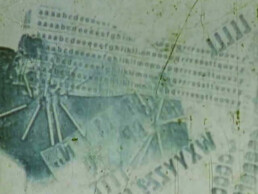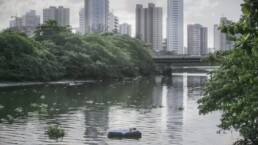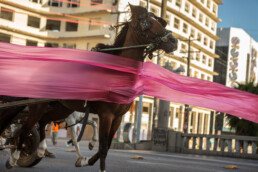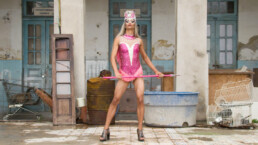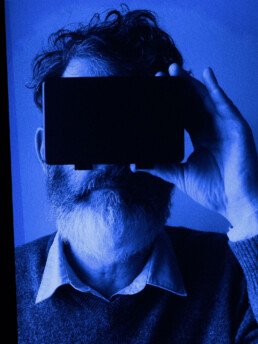FUSO INSULAR 2020 – 29 a 31 de Outubro
29 Outubro, 21h30
Igreja do Colégio, Ponta Delgada
BANDEIRA BRANCA ENFIADA EM PAU FORTE
Curadoria: Cristiana Tejo
Este programa concentra-se no experimentalismo audiovisual do Recife, um dos mais antigos e prolíficos centros do Brasil, tendo como ponto irradiador a trajectória de Paulo Bruscky, artista multimídia pioneiro em várias frentes brasileiras incluindo a videoarte, a partir do final dos anos 1970. As suas obras em Super 8, vídeo e U-Matik são experiências com a própria linguagem do filme, comentários humorados sobre a questão da representação na arte e a cidade como object trouvée. Assim como ocorreu mundialmente, a produção inicial de videoarte trouxe um novo sopro de experimentação para a linguagem audiovisual que começava a se cristalizar por conta do apelo comercial. Neste sentido, é interessante notar que este foi um dos momentos de grande fertilidade do audiovisual, em que cineastas e artistas plásticos convergiam atenção e energia para a expansão das possibilidades estéticas da imagem em movimento. O programa faz um contraponto com o momento actual em que a produção fílmica de Pernambuco ganha novamente densidade e importância nacionais e o trânsito de linguagens volta a ocorrer de maneira intensa, mas trazendo novas questões de forma e de conteúdo. Os artistas escolhidos emergiram na primeira década de 2000 no Recife e afora mesclarem as fronteiras dos campos do cinema e das artes visuais, problematizam com grande potência questões políticas locais internacionalizando-as, a exemplo do direito à cidade e a luta de grupos sociais por visibilidade além dos clichês identitários.
Cristiana Tejo
POEMA – Paulo Bruscky (BR)
1979, 3’
Nas palavras do artista “Poema é uma poesia visual, um filme onde a ponta é o filme e o filme é a ponta”. Paulo Bruscky utiliza as partes finais dos filmes de super 8 e filma-as gerando um resultado poético surpreendente.
(super 8 transferido para digital)
Xeroxfilme: LMNUWZ, FOGO! – Paulo Bruscky (BR)
1980, 25’’
Filme feito através do processo xerográfico (xerofilme), abrindo um novo campo para o desenho animado e o cinema experimental. O filme é o registro xero/gráfico da ação do artista em tocar fogo em diversos materiais em cima do visor da máquina copiadora e filmá-lo posteriormente, quadro a quadro o resultado da experiência.
(super 8 transferido para digital)
Xerofilme: AÉPTA – Paulo Bruscky (BR)
1982, 4’45’’
Aépta é um Xerofilme realizado a partir de experimentos com linhas de costurar em movimento sobre uma moldura de slide projetadas para a máquina xerox colorida através de um espelho.
(super 8 transferido para digital)
VIA CRÚCIS – Paulo Bruscky (BR)
1979, 7’40’’
Via Crucis: Proposta/acção poética realizada nas escadarias do morro do cruzeiro da cidade de Gravatá/PE, em que cada degrau tinha o nome de seu patrocinador. Paulo Bruscky e um amigo com câmera em punho sobem as escadarias na medida em que citam os nomes inscritos em cada degrau.
(super 8 transferido para digital)
SONHO DE DERIVA – Gabriel Mascaro (BR)
2013, 5’
Recife é uma cidade cortada por dois rios e seus canais, o que a levou ser chamada de Veneza Brasileira. Entretanto, há um completo descaso público sobre a saúde das águas e uma sub-utilização de seu potencial. Neste trabalho, Gabriel Mascaro lança entrelaça espaço afectivo e íntimo com o espaço público e a paisagem urbana. Um colchão flutua sobre as águas de um rio servindo de repouso para um casal que dorme em toda sua jornada, seguindo o curso natural do rio enquanto enche.
O LEVANTE – Jonathas de Andrade (BR)
2012, 8’
Em 2011 foi decretada a proibição de veículos movidos por animais no centro do Recife, medida que atingiu parcela pobre da população que se utilizava deste meio principalmente como ferramenta de trabalho. O filme O Levante foi o subterfúgio usado pelo artista para fazer este grupo social voltar a circular pelas ruas do centro. Ao mesmo tempo em que tratava com as instâncias governamentais sobre uma ficção que seria filmada, ele promovia a 1ª Corrida de Carroças no Centro da Cidade do Recife.
O CASEIRO – Jonathas de Andrade (BR)
2016, 8’
O Caseiro cria um fluxo de imagens paralelo ao criado por Joaquim Pedro de Andrade no filme O mestre de Apipucos (1959), sincronizando as duas narrativas como se fossem uma peça única. No lugar que fora do sociólogo Gilberto Freyre no filme original, há agora um homem negro que é, supostamente, o encarregado por zelar pela casa onde aquele morava. O trabalho sugere as assimetrias de posições atribuídas aos corpos brancos e pretos naqueles lugares e, por extensão, na sociedade brasileira.
FAZ QUE VAI – Barbara Wagner e Benjamin de Burca (BR)
2015, 12’
Tomando o nome de um passo de Frevo que simula um momento de instabilidade, Faz Que Vai retrata quatro bailarinos nos seus modos de articular uma forma de tradição popular em questões sócio-económicas e de género. Como uma série de anotações sobre a relação entre corpo, câmara e movimento no registo de uma dança típica do Nordeste do Brasil, Faz Que Vai comenta o sentido do carnavalesco presente em diversas estratégias de preservação do Frevo como imagem, património e produto.
FUSO INSULAR 2020 – October 29th to 31st
October 29th, 9.30pm
Igreja do Colégio – Ponta Delgada
WHITE FLAG STUCK IN A STRONG WOOD
Curator: Cristiana Tejo
This program focuses on audiovisual experimentalism in Recife, one of the oldest and most prolific centers in Brazil. Its main focus is the work of Paulo Bruscky, a multimedia artist and a pioneer on several Brazilian fronts, including video art, since the late 1970s. His works on Super 8, video and U-Matic are experiences in the language of film, humorous comments on the issue of representation in art and the city as ‘objet trouvé’. Just as it happened worldwide, the initial production of video art brought a new full breath of experimentation for audiovisual language, which was beginning to crystallize due to its commercial appeal. In this sense, it is interesting to note that this was one of the moments of great fertility for the audiovisual, in which filmmakers and visual artists converged attention and energy towards the expansion of the aesthetic possibilities of the moving image. The program is a counterpoint to the current moment, in which film production in Pernambuco gains a new national density and importance, and the language exchanges once again occur in an intense way, while bringing new questions of form and content. The chosen artists emerged in the first decade of the 2000s in Recife and, in addition to merging the frontiers of the fields of cinema and the visual arts, forcefully problematize and internationalize local political issues such as the right to the city, and the struggle of social groups for visibility beyond the clichés of identity.
Cristiana Tejo
POEMA – Paulo Bruscky (BR)
1979, 3’
In the words of the artist “Poem is a visual poetry, a film where the point is the film and the film is the point.” Paulo Bruscky uses the final parts of super 8 movies, and films them with an amazing poetic result.
(super 8 transfered to digital)
Xeroxfilme: LMNUWZ, FOGO! – Paulo Bruscky (BR)
1980, 25’’
A film made through the xerographic process (xerofilme), opening a new field for animated film and experimental cinema. The film is the xero / graphic record of the artist’s action of setting fire to various materials on top of a photocopier’s display, and later filming, frame by frame, the result of the experiment.
(super 8 transfered to digital)
Xerofilme: AÉPTA – Paulo Bruscky (BR)
1982, 4’45’’
Aépta is a Xerofilme made from experiments with sewing thread moving on a slide frame and projected onto a colored xerox machine through a mirror.
(super 8 transfered to digital)
VIA CRÚCIS – Paulo Bruscky (BR)
1979, 7’40’’
Via Crucis: Proposal / poetic action performed on the steps of Morro do Cruzeiro in the city of Gravatá / PE, in which each step shows the name of its sponsor. Paulo Bruscky and a friend with a super8 camera go up the stairs while saying the names inscribed on each step.
(super 8 transferred to digital)
SONHO DE DERIVA – Gabriel Mascaro (BR)
2013, 5’
Recife is a city divided by two rivers and their canals, for which reason it is called the Brazilian Venice. However, there is a complete public disregard for the water’s sanitary condition, and an under-utilization of its potential. In this work, Gabriel Mascaro intertwines affective and intimate space with the public space and the urban landscape. A mattress floats on the water of a river, used by a sleeping couple who throughout their journey, following the natural course of the river as the tide rises.
O LEVANTE – Jonathas de Andrade (BR)
2012, 8’
In 2011, a ban on animal-powered vehicles was decreed in downtown Recife, a measure that affected a poor section of the population that used these vehicles as a principal work tool. The film O Levante (The Uprising) was the subterfuge used by the artist to make this social group return to circulating through the streets of the center. At the same time he negotiated with the government about shooting a fiction film, he promoted the 1st Carriage Race in the Center of the City of Recife.
THE CARETAKER – Jonathas de Andrade (BR)
2016, 8’
The Caretaker (O Caseiro) creates a flux of images which parallel those created by Joaquim Pedro de Andrade in the film The Master of Apipucos (1959), synchronizing both narratives as if they were a single piece. Taking the place of the sociologist Gilberto Freyre in the original film, there is now a black man who is, supposedly, in charge of caring for the house where the former lived. The work suggests the asymmetries of the positions attributed to white and black bodies in those places and, by extension, in Brazilian society.
FAZ QUE VAI – Barbara Wagner and Benjamin de Burca (BR)
2015, 12’
Taking its title from a Frevo move that simulates a moment of instability, Faz Que Vai portrays four dancers through their ways of articulating a form of popular tradition on socio-economic and gender issues. As a series of notes on the relationship between the body, the camera and movement, in recording a dance typical of Northeastern Brazil, Faz Que Vai comments on the meaning of the carnival within various strategies for the preservation of Frevo as an image, heritage and product.

